Menus
- At maturity
- If the Duke 3 was an exotic outsider against classic roadsters, this fourth generation largely deserves its place in the family and is a credible alternative to the references of the genre thanks to a less radical placement and a finally competitive price..
- Discovery
- In the saddle
- Contact
- Motorways and expressways
- Departmental
- Braking
- Comfort / Duo
- Convenient
- Conclusion
- ITV meeting with Joerg Schueller, Product Manager at KTM
- How did you manage to plan the price of the Duke 4 by over 1000 € ?
- Those who are looking for a more radical product will they be entitled to an R version of the Duke 4 ?
- Is the RC4 project definitely buried ?
At maturity
If the Duke 3 was an exotic outsider against classic roadsters, this fourth generation largely deserves its place in the family and is a credible alternative to the references of the genre thanks to a less radical placement and a finally competitive price..
Before getting to the heart of the matter, it should be noted that the Duke occupies a place of its own in the KTM lineup. Born in 1994 in the form of a barely civilized supermotard, it represents the brand’s first real foray into the road machinery segment, well before the official orange machinery offensive in 2005 with the Superduke 990. In five years, KTM will sell nearly 10,000 copies of its single-cylinder SM, a more than appreciable score for the small Austrian firm, especially since sales in this micro niche that is the road supermotard have rarely reached peaks…. The 1999 Duke 2 will confirm this esteemed success. But when the third generation of the Duke was unveiled in 2008, the situation was different. KTM has expanded its road offer and the Duchess is – with the 690 Supermoto – its entry level. Faithful to the house philosophy of “Ready to Race”, the Duke 3 does not refuse anything: high-end suspensions, radial braking, radical design, overpowered engine (for a single cylinder) capable of pushing the whole unit to 190 km / h, handling almost impossible to fault, ergonomics reworked to comply with a more road driving style…. But sales are not exploding, far from it. Overpriced compared to Japanese bestsellers, the roadster-SM hybrid also suffers from its radical placement, inherent in KTM culture. Suddenly, the engineers at Mattighofen tried their hand at an apparently contradictory exercise, namely offering a machine that is both more efficient but less expensive to purchase and maintain, easier to access but more efficient. Impossible ? Not so sure….
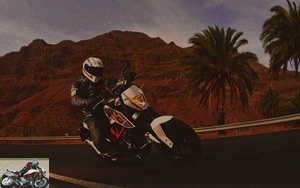
Discovery
For the fourth iteration of the Duke, KTM has renewed more than 90% of its components! The most striking difference is the abandonment of the billhook-cut lines of the previous generation in favor of more consensual features, strongly inspired by the KTM Duke 125. A relevant choice to attract fans of the little orange (best selling quarters of a liter in Europe) towards a large displacement, but the strong family link between the 125 and the 690 may well put off external customers looking for a rewarding machine ….
The “Buell-style” exhaust is therefore bowed out. Expensive to produce and inducing too great a saddle height, it was not compatible with the new specifications. It is replaced by a two-part model with a plenum chamber incorporating the catalyst – still under the engine – and a more classic silencer anchored under the right passenger footrest. The space saved under the engine, combined with a new rear loop, allows the seat height to be lowered from 865 to 835 mm. And if this is not enough, KTM has in its catalog of options a lowering kit allowing to gain an additional 30 mm.
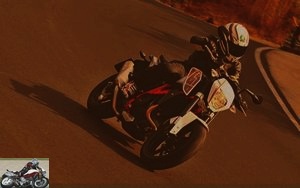
The general line is admittedly less airy than before, but the whole remains balanced and more pleasing to the eye in reality than the photos suggest. The LC4 single-cylinder also has its share of developments. The 654 cc version (65 hp and 6.8 mkg) of the “standard” Duke 3 is discontinued. The Duke 4 adopts a reworked version of the 690cc version (70 hp and 7 mkg) of the Model R which, not content to be more powerful, saw its service intervals increase from 6,500 to 10,000 km. The cylinder head has been modified to accommodate two spark plugs, each with its own map, and a "ride by wire" system connects the accelerator and the injection. Power and torque are identical but KTM announces a reduction in consumption of the order of 10%, which, coupled with a tank capacity increased from 13.5 to 14 liters, should allow the Duke 4 to greatly exceed 250 km autonomy.
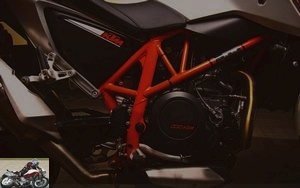
On the braking side, the machines delivered in France will all have the latest generation disconnectable ABS. A small tour de force when we know that the Duke 4 will be displayed at € 7,490 when it arrives in dealerships next March while the “3” was trading against € 8,850 when it was released in 2008. To lower the price so consistently, KTM has chosen to ignore a few refinements. As it evolves, the Duke loses almost all of its suspension settings, settling for only a rear preload adjustment and adopts standard master cylinders when the previous one had separate jar radial elements for the clutch and the front brake. The overall finish remains very good and does not suffer from this budget planer cost.
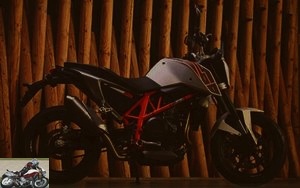
In the saddle
For small builders like mine (1.70m), stepping over the saddle of the Duke no longer requires an outrageous lifting of the paw and both feet finally touch the ground, even with track boots limiting ankle mobility. The original settings of the controls (handlebars, brake controls, etc.) are far from perfect from the outset, but once the usual adjustments have been made, the handlebar saddle footrest triangle defines a most natural driving position. whether you’re a garden gnome or a rugby pillar. Another difference in size, we have the impression of becoming embedded in the Duke 4 while we landed on the Duke 3. The hollowed out profile of the saddle is also there to remind that the Duke has finished its moult and is now placed like a real roadster.
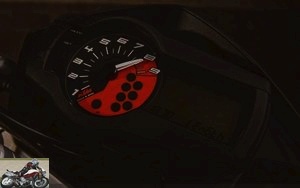
The dashboard, identical except for an indicator light indicating the activation of ABS, combines an analog tachometer and a digital odometer. At the bottom, a window can display the choice of total mileage, two partial or a gear indicator engaged.
Contact
The single cylinder snorts (too) discreetly and the grip for the first few meters is disconcertingly easy. The featherweight, a little over 160 kilos fully packed, works wonders in low-speed evolutions. Only the lack of flexibility, inherent in the architecture of single cylinders, will disconcert the uninitiated. However, the LC4 is doing better than most of its peers.
In sixth gear, it starts to bump below 3,000 rpm, a little over 65 km / h and is only really comfortable from 3,500 rpm. The benefit of the technical improvements mentioned above is more noticeable on the lower gears. The single cylinder thus accepts to resume on a trickle of gas from 2,500 turns in 2nd and 3rd and even 2,000 turns in first without risk of losing a seal. Fortunately, the smoothness of the gearbox and the clutch limits this inconvenience.
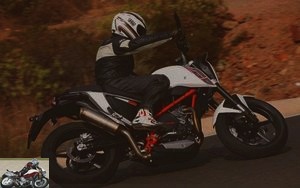
Motorways and expressways
Finally a little air! The route concocted by the KTM forerunners to reach the heights of the island of Gran Canaria takes our small group of testers through a long stretch of expressway. The road, almost deserted, allows us to test the velocity of the Duke 4. Several fast curves demonstrate flawless stability despite the large handlebars and the lack of protection. As for the maximum speed, it is located exactly at 205 km / h before the switch comes into action at 8,600 rpm.
At these high speeds, the vibrations of the single cylinder are well filtered by the saddle, the handlebars and the footrests, but it suffices to squeeze the machine a little firmly between your knees for them to reappear without however generating any real uncomfortable. The fear of the gendarme will limit our enthusiasm anyway. That’s good, the cruising speed authorized by the headlight plate surmounted by a mini-deflector without tiring is around 130 km / h.
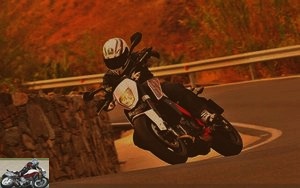
Departmental
As we gain altitude, the turns are more and more numerous and to follow the rhythm set by our “nanny” Julien Toniutti, KTM rider who finished second in the Moto Tour this year, we have to take out the big The Duke 3 was already extremely efficient on this type of terrain, the Duke 4 does just as well but plays on a different register.
The front axle is still as neutral and precise as ever, and the angle is set with the same disconcerting ease as before, aided by the very catchy Michelin Pilot Power. But the flexibility of the suspensions will surprise regulars of the brand with a more filtered bitumen reading and some untimely pumping, especially on the slightly violent changes of angles. The hydraulics, however, remain well controlled and the excellent agreement between front and rear means that the little KTM roadster is never a trap, even when it is necessary to brake on the angle facing a blind turn. which tightens. Better, it even seems more effective than its predecessor on the most degraded portions of asphalt, as much as an anti-dribble clutch ensures grain in the event of a hasty downshift..
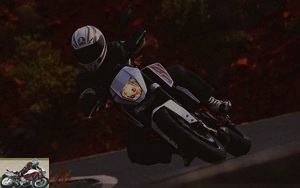
As for the single-cylinder, it offers vigorous pick-ups from 5,500 rpm but does not really reveal its true face – and all of its 70 horsepower – only in the last 2,000 laps before the red zone. The more daring, or the most gifted, can even opt for a sportier mapping under 3,500 rpm with a more frank recovery on the go-around. A "soft" setting can also be selected via an adjustment wheel hidden under the passenger seat.
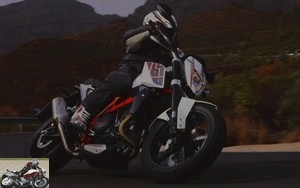
Braking
Braking is provided by a single 320mm diameter disc at the front clamped by a radially mounted four-piston caliper and, at the rear, by a 240mm element mated to a floating caliper. The whole thing is under the supervision of a latest generation Bosch 9M + ABS, already seen on the KTM SMT, but here with more sporty settings.
The front brake is particularly effective with an excellent attack and a power largely sufficient to stop the Austrian featherweight. However, we deplore a feeling of the lever behind the previous generation since the disappearance of the radial brake pump.
The full-back is doing its job well despite an untimely kick-in from the fast-paced ABS. Notwithstanding the Duke 4, the frequent variations in the adhesion of the bitumen of the Spanish island are probably not unrelated to this phenomenon. It is however possible to deactivate the control unit by pressing a simple button on the dashboard for a period of 5 seconds..
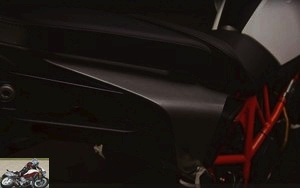
Comfort / Duo
The previous generation saddle, while not carved from solid oak, tended to tan the hindquarters as it approached the reserve. Point of that here. The element that equips the new Duke is much softer and above all wider in its rear section, a guarantee of comfort on long journeys. But the relative softness of the saddle was not to the liking of all the testers present. Note, however, that the older (and the heaviest) complained about the large compressions of pain similar to certain prison experiences involving showers and soap…. The space allocated to the passenger is in the upper average. The flat seat is comfortable and the side grab handles are well placed. Too bad the inclination forwards, too pronounced, tends to make the passenger slide on the pilot on the first hard braking.
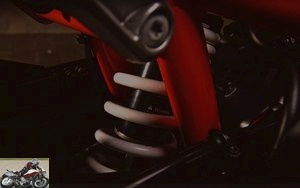
Convenient
Apart from a small space under the saddle concealing a tool kit and being able to accommodate a disc lock, the practical aspects are not legion. Fortunately, KTM’s Power Parts catalog can make a big difference, for a fee, of course..
Those on the road will be able to equip the new Duke with a set of semi-rigid side cases with a small bag to be attached behind the passenger, a screen with larger dimensions, a belly pan and protection. – aluminum hands. The pressed oranges will have a whole range of accessories capable of improving performance, look or protection..
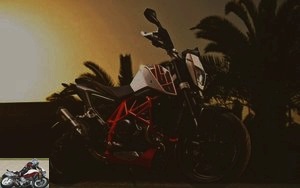
Conclusion
After 18 years of existence, punctuated by four evolutions, the Duke is a machine – finally – coming of age. KTM’s efforts to make it a more affordable machine, both financially and to drive, have paid off. If the gain in sobriety remains to be confirmed, we can already say that the latest KTM is a real roadster, light, easy to handle, comfortable and just as formidable in sporty driving as its predecessor. And with a compressed selling price of € 7,490, it is now a credible, although exotic, alternative to a bestseller like the Kawasaki ER-6N, displayed at € 7,099 in its ABS version while offering performance. similar. There remains the engine architecture which requires a particular "manual" for neophytes. The single-cylinder LC4 is a real ball of nerve but its lack of flexibility, especially in urban areas, may put off beginners and addicts to four cylinders. Those who take the plunge, however, will be delighted.
Strong points
- Getting started
- Performances
- Consumption
- The character of the single cylinder
Weak points
- The character of the single cylinder
- The design too close to that of the 125
Competitors:
BMW F 800 R, Ducati Monster 696, Kawasaki ER-6N, Suzuki SV 650, Yamaha MT-03
The technical sheet of the Duke 690
ITV meeting with Joerg Schueller, Product Manager at KTM
How did you manage to plan the price of the Duke 4 by over 1000 € ?
We had to make choices. The move away from adjustable suspensions and high-end peripherals like the radial clutch master cylinder allowed us to save substantial amounts of money. I can also mention the adoption of body parts tinted in the mass less expensive than painted ones or the new exhaust and the new cast aluminum frame rear loop, also less expensive. To quote here all the modifications would be too long but we carried out a fundamental reflection to rationalize the production costs on the maximum of elements without cutting back on the overall quality. Engine and chassis are still made in Austria, but triple trees are produced in India. You should also know that a few hundred euros saved in production translate into amounts significantly higher than the selling price, which allowed us to amortize the additional cost of engine development and the integration of ABS ….
Those who are looking for a more radical product will they be entitled to an R version of the Duke 4 ?
In any case not this year! We must first see if the Duke 4 finds are public…. On the other hand, a 350 cc version is already programmed and should make its appearance within fifteen months.
Is the RC4 project definitely buried ?
There are many people at KTM who find the project attractive but the demand for this type of machine is still too low for such a product to be viable..
Related articles
-
KTM 390 Adventure motorcycle test
Reverse osmosis Single cylinder, 373.2 cm3, 43.5 hp and 37 Nm, 172 kg full made, 6,699 euros For a long time the market was the queen of medium and large…
-
Light is Right ! The little Duke 390 is an amazing machine. Ultra light and very powerful without being radical, it comes to hunt on the lands of the…
-
Honda Varadero 1000 XLV motorcycle test
Maxi-Trail with a road vocation The Honda XL 1000 V Varadero, which appeared in 1998, is the heir to the famous Africa Twin … but the manufacturer has…
-
A remarkable entry for KTM in the most profitable segment of the market Inline twin, 799 cc, 105 hp at 9000 rpm, 87 Nm at 8000 rpm, 169 kilos, from ¤…
-
Asphalt AND mud in fun mode The range of light trails was born in 1993 with the F 650 GS. Powered by a Rotax single cylinder, the small everyday BMW was…
-
Test carried out during a Track ‘N’ Test day on the Bresse circuit. The KTM RC8 is the first sports car of the Austrian brand, unveiled in 2003 with 990…
-
Yamaha Thunderace 1000 YZF motorcycle test
Biker test: Jean-Michel I my name is Jean-Michel (JeanMi for close friends), from 42 but today in the 74 for professional reasons. I have 23 years old…
-
Discovery From the first approach, the NSR is reminiscent of a light CBR … Otherwise said, a super sporty, but with a smaller engine. For a 125, we…
-
Yamaha Tracer 700 motorcycle test
Sport touring or the modern day SUV Don’t call me trail anymore! Call me sport touring! And here are all the certainties which disappear on all these new…
-
Evolution Like few models, the Z can boast of having built a first name within its own brand. After eight years of hegemony in the flagship motorcycle…
David, some remarks on the form:
 . Either it’s 100cc more (796), or 400cc more (1100).
. Either it’s 100cc more (796), or 400cc more (1100).
 .
.
– in conclusion: "the more seasoned pilots will turn to the model cubing 200cc more" -> 696 + 200 = 896 (one will say 900). It’s been a long time since the Monster 900 disappeared
– uh, dynamic photos, we got better, didn’t we? Will have to make progress in yarn
David, "The Monster is definitely a selfish motorcycle and the passenger doesn’t really fit in except for a very short ride." you could have developed…
Personally, I find that the Monster is rather better placed for the duo than its competitors (Z750, Street Triple), on which the saddle is rikiki or the footrests provided for contortionists, or even both…
Granted, it’s not an XJR 1300 or a GSX 1400, but that’s okay, especially since the suspension does its job pretty well.
Hello,
Everything is said 🙂 It’s a good compromise and the Ducati Performance kit saves 13% of power with FR homologation. We go from 85 to 95hp quickly for 167kg !!!
Have fun.
85 to 95 hp approved I have doubts. With the complete racing kit yes, but without baffles, so no longer approved
A good test for a good motorcycle! However, I did 7000km on board and I do not share the opinion on the times that I find a little sluggish in 2nd or 3rd at around 4000 laps.
And I find that the rear brake locks rather easily on the contrary!
Complete test .good video .a good model in the Ducati range with its shifter
and the adjustable fork that I place as an option when I could only see through the 1200, but the unique color is not great.
amazing the comparison with the mt-07
Who in my opinion does not play in the same category when it comes to power.
And therefore price…
I will rather compare it to the next one
KTM 890 and in this confrontation
I find it a decisive advantage а
This Ducati: its seat height which
makes it accessible to little ones like me ..
Okay, first impressions … It seems that this Monster has beginners (wealthy) and even female customers in its sights. Which is not a bad thing.
Apart from the exhaust below as ugly as that of an MT, and which makes the addition of the optional engine guard (assuming that it hides this misery), and equipment in "golden" suspensions (a future model) almost obligatory. Monster ++?) With the kivonbien settings I think it’s overall a success.
So yes, there is more the lattice. Personally, the turning radius of my M1200 aircraft carrier is THE big flaw: it is to the point that in the event of a wrong course it is imperative to find a farmyard to turn around
Remarkable point: despite a saddle height of 820mmm a pilot of 1.70m sets the feet
Ducati has thought of the little ones
.. unlike KTM with its ever higher 890 r …
Nice new Gladius …
It is true that the low revs are not easy to tame. Better to stay in the towers. Otherwise, it’s super manoeuvrable, in town, small road, it sneaks. The top !!!. The highway, we muscle our arms . The yen vibrations are not much. Really a lot of fun.
. The yen vibrations are not much. Really a lot of fun.
When I was younger I found the 748 magnificent, racy and so stylish. But dear. Then at the same time the SS started to challenge me … the more I saw her with her shark’s mouth, her half fairing, her two pots the more I liked her. So much so that I bought it. What charm. Unriveable on the road I actually screwed up but what a character what a look I miss 15 years later. A little detour to the Greens, without interest then love at first sight for the s2r monster. What a beautiful bike. What a beautiful engine. And easier to ride, but we agreed, I hiked in the mountain roads to follow very zen behemists. I adored her, demanding and passionate. 5 years of BM later, irreproachable objectively better. I just sold it and I don’t think about it anymore. When I saw the pictures of the new monster I rushed to triumph to order a street r. No doubt the new monster is excellent. You just have to forget that it is ugly and tasteless, sorry, flawless. Like my old BM. If I buy a Duke or a MV it is not to have the ugly and tasteless perfection that falls into oblivion as soon as it is sold. Unforgivable.
To put it in competition with 2 three cylinders Triumph or Yamaha? Yes, provided you like the 3 cylinders. Otherwise the competition in bi is limited for the moment to KTM.